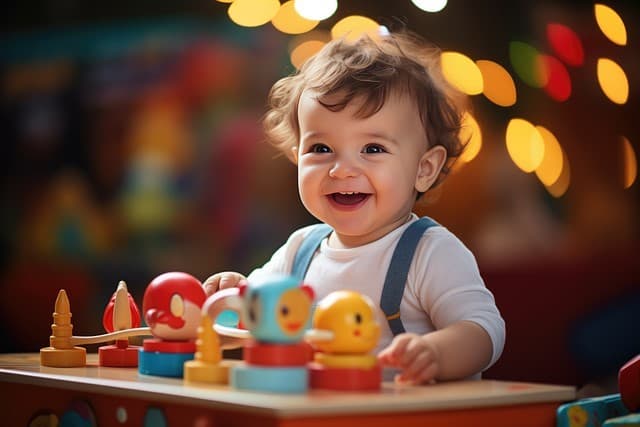Piaget’s Sensorimotor Stage: How it shapes early learning

The first two years of life are nothing short of miraculous. Every coo, giggle, and curious glance hides profound discoveries as children explore their world for the first time. While these moments might seem mundane, they are, in fact, the foundation of human learning and cognition. Swiss psychologist Jean Piaget described this period as the Sensorimotor Stage, the first step in his famous theory of cognitive development. This stage is a cornerstone for understanding how infants develop from reflexive newborns into inquisitive toddlers with a budding understanding of the world.
What Is the Sensorimotor Stage?
Jean Piaget’s Sensorimotor Stage spans from birth to approximately 2 years old. During this time, infants learn primarily through their senses (sight, touch, taste, hearing, and smell) and motor actions (grasping, crawling, and walking). Piaget emphasized that children are like little scientists—observing, experimenting, and discovering the rules of the world around them [1][1].
The Sensorimotor Stage lays the groundwork for critical milestones such as problem-solving, memory, language, and social interaction. It is during this stage that children develop object permanence, an understanding that objects exist even when out of sight—a monumental leap in cognitive ability.
Breaking Down the Sensorimotor Stage
Piaget identified six substages within the Sensorimotor Stage, each highlighting a distinct aspect of development. Let’s dive into each substage and explore how they manifest in your baby’s behavior.
Reflexes (Birth to 1 Month)
Babies Begin to Explore
Children rely on innate reflexes, such as sucking and grasping, to interact with their environment. Cognitive progress starts with these basic, automatic responses.
Parent Tip: Encourage these reflexive movements by providing opportunities for touch and gentle interaction, such as skin-to-skin contact.
Primary Circular Reactions (1–4 Months)
Discovering Repetition
Children begin to repeat actions that are pleasurable and involve their own bodies, such as sucking their thumb. Behavior focuses on their body rather than external objects.
Parent Tip: Provide soft, safe objects for children to explore, such as teething rings, to support this stage.
Secondary Circular Reactions (4–8 Months)
Interacting with the World
Attention shifts to external objects as infants repeat actions that trigger responses in their surroundings, such as shaking a rattle. They begin to understand their ability to influence the environment.
Parent Tip: Offer toys that make sounds or light up to encourage exploration.
Coordination of Secondary Circular Reactions (8–12 Months)
Goal-Oriented Behavior
Children coordinate multiple actions to achieve specific goals, such as pulling a cloth to retrieve a hidden toy. They begin to exhibit object permanence, understanding that objects continue to exist even when out of sight.
Parent Tip: Play hide-and-seek with objects to strengthen this skill. This activity also introduces the concept of object permanence.
Tertiary Circular Reactions (12–18 Months)
Experimenting with Actions and Consequences
Known as "little scientists," children experiment with new behaviors to explore and learn about objects, such as dropping items to observe their fall. They start to grasp cause-and-effect relationships.
Parent Tip: Allow safe exploration by providing toys that can be stacked, nested, or sorted. Be patient with repetitive actions—they are learning tools!
Early Representational Thought (18–24 Months)
Symbolic Thinking Emerges
Children develop internal mental representations, enabling symbolic thought and problem-solving. They engage in pretend play and demonstrate a complete understanding of object permanence.
Parent Tip: Encourage pretend play with simple props like dolls or kitchen sets to stimulate their imagination.
Key Concept: Object Permanence
One of the most celebrated milestones during the Sensorimotor Stage is the development of object permanence—the understanding that objects continue to exist even when they are out of sight. It is crucial for memory and the ability to form stable concepts about the world.
Research Insight
Research suggests that the foundational signs of object permanence may emerge as early as 3-4 months, as modern studies [2][2] indicate through infants’ prolonged attention to impossible events. Piaget's classic research posits that noticeable development occurs around 8 months. This ability gradually matures throughout the Sensorimotor Stage (0-2 years) and becomes fully developed by approximately 18-24 months, coinciding with more complex cognitive skills like hidden object search and reasoning. This highlights a more gradual developmental trajectory than initially proposed by Piaget.
How to Foster This Skill:
- Play peek-a-boo to reinforce the idea that you still exist even when your face is hidden.
- Hide a toy under a blanket and encourage your baby to find it.
The Science of Sensory Play
Modern research supports Piaget’s emphasis on sensory exploration during this stage. Studies show that sensory-rich environments can enhance cognitive development by stimulating neural pathways in the brain [3][3].
Examples of Sensory Play:
- Tactile: Use textured toys or fabrics to develop a sense of touch.
- Visual: Introduce high-contrast books or toys for visual stimulation in younger infants.
- Auditory: Play gentle music or provide rattles for auditory engagement.
Modern Applications of Piaget’s Theory
Piaget’s insights remain highly influential in early childhood education. Programs like Montessori schools emphasize sensory exploration and self-directed learning, principles deeply rooted in Piaget’s theories.
Impact on Parenting Trends:
- The focus on screen-free environments aligns with Piaget’s belief in active exploration.
- Toys designed to enhance sensory and motor development are increasingly popular.
Conclusion
The Sensorimotor Stage is a whirlwind of discovery. From the first reflexive grasp to symbolic play, every moment represents a stepping stone toward cognitive growth. Understanding Piaget’s theory can empower parents or caregivers to foster a child’s development intentionally and joyfully.
So, the next time a child drops their spoon for the hundredth time, it is not just a mess—they are experimenting, learning, and growing. As a child’s first teacher, caregivers play a crucial role in helping them unlock the wonders of the world.